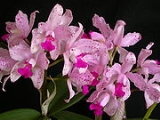
Cattleya amethystoglossa
Encyclopedia
Cattleya amethystoglossa (the "amethyst-lipped Cattley flower") is a bifoliate species of orchid from the genus Cattleya
.
C. amethystoglossa is native to Brazil
in the states of Bahia
and possibly Espirito Santo
, where it is found near sea level in close proximity to the Atlantic Ocean
. C. amethystoglossa grows on palm tree trunks, rock, and large tree branches high in the canopy of evergreen trees. This plant is found growing in bright, airy, humid locations. Its native range has been greatly reduced due to habitat destruction, logging, and agriculture.
C. amethystoglossa is a tall plant and has pseudobulbs that grow to 3 feet (1 meter) tall. Each pseudobulb has two (occasionally three) leathery, green leaves at the top. This species is in the Bifoliate division of Cattleyas.
The flowers of C. amethystoglossa grow to 4 inches (10 cm) in diameter. Flowers are produced on terminal flower stems that develop at the apex of the pseudobulb. The unbranched inflorescence produces between ten and 30 blooms. C. amethystoglossa is fragrant. The petals and sepals are light lavender to pale rose in color with mauve or magenta spotting. The amount of spotting varies widely between individuals with some individuals demonstrating few spots. The lip is bright magenta in color and partially wraps around the column. The throat varies in color from white to pale yellow or gold. Flowers are produced from late fall to early spring.
C. amethystoglossa grows best in intermediate or warm growing conditions.
This species is closely related to C. guttata
in many ways but differs in flower color and other minor botanical details. There have been a few coerulea and alba forms found in the wild.
There are several synonyms for this species: Cattleya amethystoglossa var. lilacina, Cattleya guttata keteleerii, Cattleya guttatta lilacina, Cattleya guttata prinzii, Cattleya guttata var. prinzii, Cattleya purpurina, Epidendrum amethestoglosum, Epidendrum elatius var. prinzii.
Cattleya
Cattleya is a genus of 113 species of orchids from Costa Rica to tropical South America. The genus was named in 1824 by John Lindley after Sir William Cattley who received and successfully cultivated specimens of Cattleya labiata that were used as packing material in a shipment of other orchids...
.
C. amethystoglossa is native to Brazil
Brazil
Brazil , officially the Federative Republic of Brazil , is the largest country in South America. It is the world's fifth largest country, both by geographical area and by population with over 192 million people...
in the states of Bahia
Bahia
Bahia is one of the 26 states of Brazil, and is located in the northeastern part of the country on the Atlantic coast. It is the fourth most populous Brazilian state after São Paulo, Minas Gerais and Rio de Janeiro, and the fifth-largest in size...
and possibly Espirito Santo
Espírito Santo
Espírito Santo is one of the states of southeastern Brazil, often referred to by the abbreviation "ES". Its capital is Vitória and the largest city is Vila Velha. The name of the state means literally "holy spirit" after the Holy Ghost of Christianity...
, where it is found near sea level in close proximity to the Atlantic Ocean
Atlantic Ocean
The Atlantic Ocean is the second-largest of the world's oceanic divisions. With a total area of about , it covers approximately 20% of the Earth's surface and about 26% of its water surface area...
. C. amethystoglossa grows on palm tree trunks, rock, and large tree branches high in the canopy of evergreen trees. This plant is found growing in bright, airy, humid locations. Its native range has been greatly reduced due to habitat destruction, logging, and agriculture.
C. amethystoglossa is a tall plant and has pseudobulbs that grow to 3 feet (1 meter) tall. Each pseudobulb has two (occasionally three) leathery, green leaves at the top. This species is in the Bifoliate division of Cattleyas.
The flowers of C. amethystoglossa grow to 4 inches (10 cm) in diameter. Flowers are produced on terminal flower stems that develop at the apex of the pseudobulb. The unbranched inflorescence produces between ten and 30 blooms. C. amethystoglossa is fragrant. The petals and sepals are light lavender to pale rose in color with mauve or magenta spotting. The amount of spotting varies widely between individuals with some individuals demonstrating few spots. The lip is bright magenta in color and partially wraps around the column. The throat varies in color from white to pale yellow or gold. Flowers are produced from late fall to early spring.
C. amethystoglossa grows best in intermediate or warm growing conditions.
This species is closely related to C. guttata
Cattleya guttata
Cattleya guttata is a bifoliate Cattleya species of orchid. The diploid chromosome number of C. guttata has been determined as 2n = 40.-Footnotes and External Links:...
in many ways but differs in flower color and other minor botanical details. There have been a few coerulea and alba forms found in the wild.
There are several synonyms for this species: Cattleya amethystoglossa var. lilacina, Cattleya guttata keteleerii, Cattleya guttatta lilacina, Cattleya guttata prinzii, Cattleya guttata var. prinzii, Cattleya purpurina, Epidendrum amethestoglosum, Epidendrum elatius var. prinzii.

